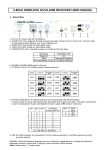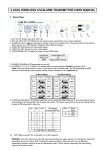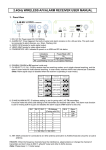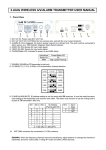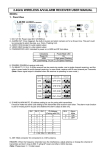Download 5.8GHz WIRELESS A/V/ALARM TRANSMITTER USER MANUAL
Transcript
5.8GHz WIRELESS A/V/ALARM TRANSMITTER USER MANUAL 1. Panel View 1. 2. 3. 4. 5. 6. 1 2 3 4 5 6 7 8 9 10 ○ ○ ○ ○ ○ ○ ○ ○ ○ ○ DC+12V IN: Power input DC+12V/1.5A. DC+12V OUT: DC+12V/750mA for box camera only, and with the over current protector. (Note: If you don’t use this port for cameras, you can use the DC+12V/500mA adaptor.) ALARM IN: Once triggered, the built-in buzzer rings on for a 20-sec time. This port could be connected to alarm sensor, e.g.: PIR Detector, Magnetic Reed Switch Detector. AUDIO IN: RCA female for input audio signal. VIDEO IN: BNC female for input video signal. POWER/State LED: Indicated to power on and ARM status. Indications Power On ARM Power/State LED On High speed Flashing 7. DISARM: DISARM at TX transmitter’s side only. 8. CH SELECT (A B C D): 5.8GHz transmission channel selection. 9. ID AND ALARM MUTE: ID address setting is use for paring with RX receivers. It must be make the same code setting to link transmitter and receiver each other. The alarm mute function is use for muting built-in buzzer at TX transmitter’s side only. Bit 1 0 0 0 0 1 1 1 1 10. Bit 2 Bit 3 ID Address (Pairing with RX) 0 0 0 0 1 1 1 0 2 1 1 3 0 0 4 0 1 5 1 0 6 1 1 7 (1 = SW ON, 0 = SW OFF) Bit 4 0 1 Alarm Mute ON OFF ANT: RP-SMA connector for connected to 5.8 GHz antenna. REMARK: When the frequency channels have the interference, adjust antenna or change the channel of transmitter and don’t close to 802.11 a/b/g AP router and other 5.8GHz devices. (Note: Please keep 3 ~ 5 meter away) 2. Caution for Installation 2.1 Be careful, never let any water in this equipment. 2.2 If necessary, use a soft cloth moistened with alcohol to wipe off the dust. 2.3 Be extra careful not to shake the unit. 2.4 Avoid places where temperatures exceed 50 o C or higher. 2.5 Avoid places where there are frequent vibrations or shocks. 2.6 When any abnormalities occur, make sure to unplug the unit and contact your local dealer. 3. Packing 3.1 Transmitter 3.2 Antenna 3.3 User manual 3.4 Screws 3.5 Plastic-Conical-Anchor 3.6 Power Adaptor ×1 ×1 ×1 ×4 ×4 ×1 [Option] 4. Specification CHANNAL FREQUENCY RF IMPEDANCE POWER CURRENT CONSUMPTION DC OUTPUT RF OUTPUT POWER VIDEO INPUT AUDIO INPUT ALARM INPUT DIMENSIONS CH1 CH2 CH3 CH4 CH5 CH6 CH7 5740 5752 5771 5790 5809 5828 5847 MHz MHz MHz MHz MHz MHz MHz 50 Ω Typical DC12V/1.5A Adaptor 230 mA Typical;Start-up current 500mA ( DC12V Input) DC12V/750mA 10mW 1.0 Vp-p Composite @ 75Ω 2.0 Vp-p Typical, 3.0 Vp-p Max. @ 600Ω TTL/CMOS (Level Detection) L:85 mm H:30 mm D:16 mm CH8 5860 MHz FCC Part 15 Notice: This equipment has been tested and found to comply with the limits for a Class B digital device, pursuant to part 15 of the FCC rules. These limits are designed to provide reasonable protection against harmful interference in a residential installation. This equipment generates, uses and can radiate radio frequency energy and, if not installed and used in accordance with the instructions, may cause harmful interference to radio communications. However, there is no guarantee that interference will not occur in a particular installation. If this equipment does cause harmful interference to radio or television reception, which can be determined by turning the equipment off and on, the user is encouraged to try to correct the interference by one or more of the following measures: -Reorient or relocate the receiving antenna. -Increase the separation between the equipment and receiver. -Connect the equipment into an outlet on a circuit different from that to which the receiver is connected. -Consult the dealer or an experienced radio/TV technician for help. 1. This Transmitter must not be co-located or operating in conjunction with any other antenna or transmitter. 2. This equipment complies with FCC RF radiation exposure limits set forth for an uncontrolled environment. This equipment should be installed and operated with a minimum distance of 20 centimeters between the radiator and your body. 3. Any changes or modifications (including the antennas) made to this device that are not expressly approved by the manufacturer may void the user’s authority to operate the equipment. Q2010/05/17


